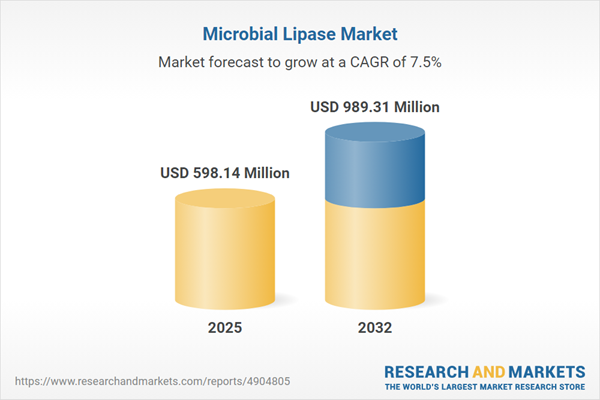Speak directly to the analyst to clarify any post sales queries you may have.
Microbial lipase is transforming how industries approach sustainable manufacturing and bio-based production. Its application is advancing operational efficiency, supporting eco-conscious innovation, and enabling organizations to align with modern regulatory and consumer priorities.
Market Snapshot: Microbial Lipase Market Trends & Growth
The microbial lipase market is experiencing clear growth, moving from USD 556.54 million in 2024 to USD 598.14 million in 2025. Sustained by a projected CAGR of 7.45%, expectations point to a value of USD 989.31 million by 2032. Growth is underpinned by widespread adoption across detergent, pharmaceutical, and personal care industries, with new developments in fermentation processes and microbial engineering driving industrial innovation. As sustainable chemistry becomes a global focal point, organizations are harnessing microbial lipase for regulatory compliance, consumer preference alignment, and to strengthen environmental credentials.
Scope & Segmentation
- Source: Bacteria, fungi, and yeast each play a pivotal role, with selection based on manufacturing yield, environmental conditions, and target substrate compatibility.
- Form: Available in liquid or powder, these forms address differing needs in integration, transportation, and storage across manufacturing setups.
- Production Process: Solid state fermentation and submerged fermentation provide alternatives for scaling production, ensuring product purity, and optimizing process efficiency.
- Application: Applied in biodiesel production, detergent formulation, animal feed (including aquafeed, livestock, and pet food), as well as food and beverages (covering bakery, confectionery, beverages, and dairy), leather and textiles, personal care (notably haircare and skincare), and pharmaceuticals and nutraceuticals (encompassing diagnostics and therapeutics).
- Distribution Channel: Reach is established through direct sales, distributive partnerships, resellers, and fast-expanding online channels such as e-commerce platforms and manufacturer websites.
- Regions: The market spans the Americas, Europe, Middle East & Africa, and Asia-Pacific, with dynamic growth seen in both established and emerging economies, and regional hubs arising in the Gulf, Western and Eastern Europe, and Africa.
- Leading Companies: Key players include Novozymes A/S, Koninklijke DSM N.V., BASF SE, DuPont de Nemours, Inc., AB Enzymes GmbH, Amano Enzyme Inc., Advanced Enzymes (India) Ltd., Biocatalysts Ltd, Chr. Hansen Holding A/S, and Kerry Group plc, who contribute through innovative product development and global distribution.
Key Takeaways
- Bacterial lipases are frequently chosen for their adaptable manufacturing yields, while fungi and yeast sources excel in processes demanding thermal resilience or substrate specificity.
- Solid state and submerged fermentation processes are fundamental to tailoring production, supporting scalability and ensuring reliable product consistency.
- Sustainable production priorities across sectors such as detergents and biodiesel are intensifying reliance on microbial lipase, driving efforts to lessen the overall environmental footprint of manufacturing operations.
- Personal care and pharmaceutical companies increasingly turn to microbial lipases for their specificity, enabling advanced formulations that can address specialized requirements in high-value end products.
- Distribution models are evolving, illustrated by a shift to direct sales and online channels, which is notably enhancing access to these enzymes in decentralized and rapidly growing regions.
- Ongoing competition is steered by accelerated technology investments, new strategic partnerships, and an emphasis on translating research and development directly to commercial scale.
Tariff Impact: Microbial Lipase Supply Chain Adaptations
Recent tariff changes in the United States have influenced microbial lipase supply chains, prompting manufacturers to extend their supplier networks and invest in local production sites. These strategic adjustments help reduce the impact of potential disruptions and support more agile, regionally responsive supply chains. By localizing manufacturing expertise, companies are able to ensure reliable product flow and strengthen their position in geographically important markets.
Methodology & Data Sources
This report integrates direct interviews with industry executives, technical specialists, and facility managers. Insights are further substantiated through evaluations of technical literature, patent filings, and regulatory documents. Data triangulation techniques were applied to offer precision and clarity in the assessment of structural and emerging industry trends.
Why This Report Matters
- Enables executive teams to proactively manage evolving regulatory and technological shifts, identify emerging market risks, and determine potential entry or expansion opportunities.
- Supports strategic resource allocation and partnership planning through clear, actionable analysis of competitive dynamics, supply chain resilience, and technology transfer patterns.
- Provides in-depth segmentation to help prioritize the most relevant applications and regions, ensuring well-informed decisions that align with organizational goals.
Conclusion
The microbial lipase market is undergoing substantial change, driven by technological advancements, regulatory considerations, and shifting end-user priorities. Future growth and industry leadership will depend on ongoing collaboration, strategic planning, and informed investment in innovation.
Additional Product Information:
- Purchase of this report includes 1 year online access with quarterly updates.
- This report can be updated on request. Please contact our Customer Experience team using the Ask a Question widget on our website.
Table of Contents
3. Executive Summary
4. Market Overview
7. Cumulative Impact of Artificial Intelligence 2025
List of Figures
Samples

LOADING...
Companies Mentioned
The key companies profiled in this Microbial Lipase market report include:- Novozymes A/S
- Koninklijke DSM N.V.
- BASF SE
- DuPont de Nemours, Inc.
- AB Enzymes GmbH
- Amano Enzyme Inc.
- Advanced Enzymes (India) Ltd.
- Biocatalysts Ltd
- Chr. Hansen Holding A/S
- Kerry Group plc
Table Information
| Report Attribute | Details |
|---|---|
| No. of Pages | 187 |
| Published | October 2025 |
| Forecast Period | 2025 - 2032 |
| Estimated Market Value ( USD | $ 598.14 Million |
| Forecasted Market Value ( USD | $ 989.31 Million |
| Compound Annual Growth Rate | 7.4% |
| Regions Covered | Global |
| No. of Companies Mentioned | 11 |









